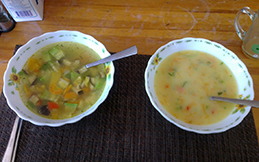I love to travel, and for most people one of the best parts of travelling is the food. But for me food is a different kind of adventure. For me the questions that arise are: Will I be able to find anything to eat? Will I be able to communicate my needs? Can I trust the food I do end up with? You see, I have coeliac disease, which means I’m allergic to gluten, specifically the grains wheat, oats, rye and barley and any product that they’re in. Gluten’s only found in those four grains so I can eat other grains such as rice, maize (corn), millet and buckwheat.

So what are my first steps? Well, when booking airline tickets you need to make sure that they’re aware of your needs straight away. Most airlines on long haul flights will provide gluten intolerant meals (only rarely snacks). A notable exception is American Airlines, which will only look after first and business class allergy sufferers; in cattle class they don’t care.
Take initial supplies. I have never in an airport (so far) had muesli bars, packet nuts, crackers or cereal taken off me. So your breakfast and snack needs for a short trip can be taken with you. Keep them in their packs, though I have not had any problem regardless; the issue is mainly fresh fruit. Unfortunately for me this is only a short term solution; I normally travel long, long term, 10 to 12 months at a time.
Try to get some idea from the Internet of what type of food is available and good shopping spots. Normally, the search term goes something like this: ‘Gluten free in …’ (for instance ‘Gluten free in Nepal’). This will normally give you a variety of sites and blogs with tips, ideas and shopping and restaurant recommendations. In China, Beijing has a chain of supermarkets called Jenny Lou’s that caters for Westerners and stocks food from all over the world. They have gluten-free cereals, crackers and muesli bars. In some countries chemists stock the gluten free food, so be sure to go on reconnaissance walks when you first hit a country.
Learn some language, specifically how to recognise the important flours on ingredient lists when you go shopping. The easiest way is to use Google Translate or other online translators. Individually put in the flour names and note down what they are and how to say them e.g. in Spanish wheat is trigo. Enter the information on a card so you can communicate in writing if your pronunciation lets you down. But keep it simple.
Same rule applies for a restaurant card. I have found the online ones too complicated; restaurant staff normally give up and shake their heads. I have had much more success making my own using Google or Bing Translate and taking a screenshot, and then showing it on my phone. My card says the following:
Most flour makes me sick (wheat, oats, barley, rye)
No bread
No pasta
No noodles
No soy sauce
Is what I have chosen safe for me to eat?
Make sure you know what the words yes, no and thank you are in their language. This has worked quite well. You will also find lots of helpful bilingual strangers will jump in and offer their services when you are in difficulty. Let them help.
If you have an included breakfast then let the hotel know your needs in advance. In Norway I didn’t find out until the second morning that they had gluten free bread in the freezer. I just needed to let them know and they would pull out several slices for breakfast. It never hurts to ask. Fill up on breakfast so you can survive on snacks through lunch if necessary.

Worst country? Unfortunately I would have to say China. As coeliac disease is not very common among Asians they do not have any concept of allergy control. The normal way of eating is to pool all the dishes on a revolving disc in the middle of a big round table and everybody eats right off the dishes. Therefore contamination is virtually impossible to avoid; I would have to rush to get everything I could eat first before everyone else tucked in. If the tour guide tried to explain my needs I would get dishes made for me but they would normally consist of plain rice, a bowl of broccoli and a bowl of celery. I had success with my restaurant card at some restaurants with friendly attentive staff and a picture menu, but it would be hit and miss.

Best countries? The whole of Central America: the focus on maize makes their diet easy for coeliacs, and most of their sauces are safe (just make sure you specify maize tortillas because if the menu says flour tortillas that normally means wheat flour). Also India and Nepal, as they use so many different types of flour that you have a lot of options. In India, a lot of restaurants serve ‘missi roti’ which is bread made with chickpea flour. Pappadams are made with lentil flour, which also applies to Nepal where their national dish is ‘dhal bhat’, a complete all you can eat meal with lentil soup, veg curry, pickles, pappadams, yoghurt and rice, all gluten free. I found that travelling in these two countries was a gastronomical delight as I could experiment and eat all local like a normal traveller. Nepal had regional surprises such as buckwheat pancakes in Eastern Nepal and sal roti (a rice doughnut) in Western Nepal. Yummy times.

Long story short, don’t let your diet stop you from travelling. I’ve found a lot of countries even more coeliac aware or the diet more friendly than Australia’s, which is pretty good. Brazil has fantastic labelling laws where every product has a ‘contem gluten’ or ‘nao contem gluten’ statement on it, even the water! Some countries are more difficult than others, but that is all part of the adventure. Always have snacks on hand (nuts are good) and a contingency plan. Travelling is much much more than just the food, so get out there and enjoy all the experiences the world has to offer; it is easier than you think.
About the author: Michael and Elizabeth Fab have travelled with Tucan Travel on many of their group tours in different regions around the world. Read more of their posts here.

